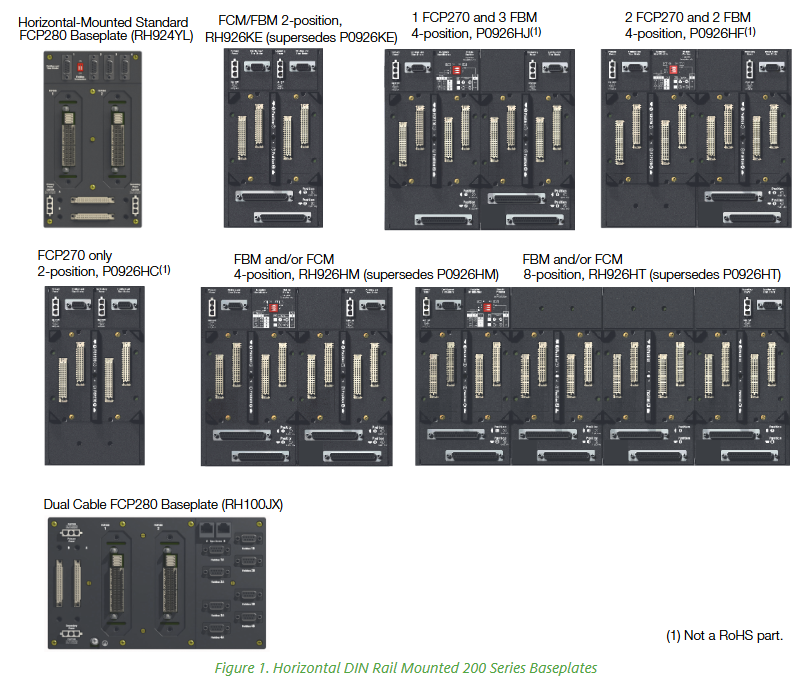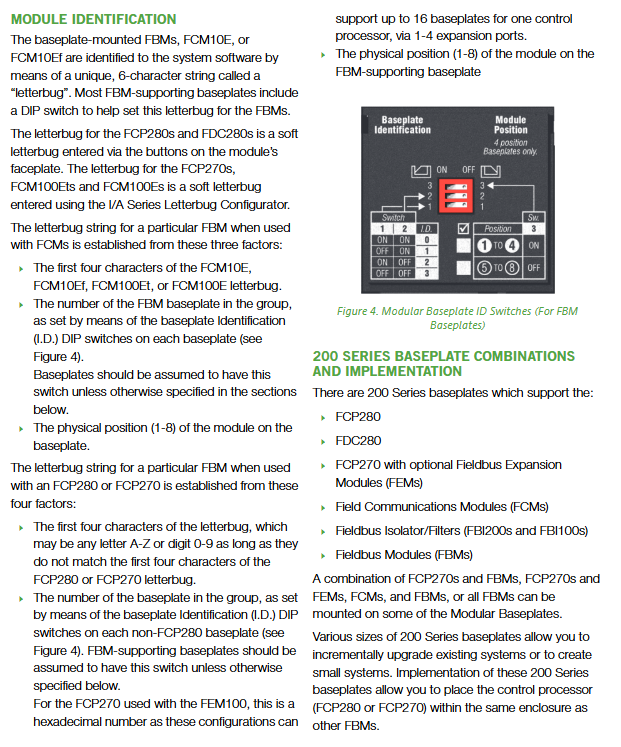Foxboro Evo ™ Standard 200 Series Baseplates(PSS 31H-2SBASPLT)
Module carrying and positioning: providing standardized slots for adaptation Field Control Processor(FCP)、Field Device Controller(FDC)、Field Communications Module(FCM)、Fieldbus Module(FBM) Waiting for multiple types of modules to achieve modular layout;
Signal and power distribution: Built in 2 Mbps HDLC redundant serial bus (Module Fieldbus), responsible for data exchange between modules; Simultaneously provide 24V DC redundant power interface to provide stable power supply for all mounted modules;
Redundancy and Scalability Support: Compatible with module level redundancy (such as FCP/FDC redundancy pairs), and supports online addition of substrates (requiring redundant buses) to meet system expansion requirements;
Compatibility Connection: Downward compatible with 100 Series FBM (requiring 268 Kbps fieldbus), upward compatible with Foxboro Evo control network, achieving smooth transition between old and new systems.
Foxboro Evo ™ Standard 200 Series Baseplates(PSS 31H-2SBASPLT)
Core positioning and subsystem roles
The standard 200 series substrate is Foxboro Evo ™ The core functions of the "hardware connection center" of the system include:
Module carrying and positioning: providing standardized slots for adaptation Field Control Processor(FCP)、Field Device Controller(FDC)、Field Communications Module(FCM)、Fieldbus Module(FBM) Waiting for multiple types of modules to achieve modular layout;
Signal and power distribution: Built in 2 Mbps HDLC redundant serial bus (Module Fieldbus), responsible for data exchange between modules; Simultaneously provide 24V DC redundant power interface to provide stable power supply for all mounted modules;
Redundancy and Scalability Support: Compatible with module level redundancy (such as FCP/FDC redundancy pairs), and supports online addition of substrates (requiring redundant buses) to meet system expansion requirements;
Compatibility Connection: Downward compatible with 100 Series FBM (requiring 268 Kbps fieldbus), upward compatible with Foxboro Evo control network, achieving smooth transition between old and new systems.

Classification and core functions of substrates
According to the number of slots (2/4/8), installation direction (horizontal/vertical), and supported module types, Standard 200 series substrates can be divided into multiple categories. The core functions and adaptation scenarios of each category are shown in the table below:
Substrate type, slot number, installation direction, support module/core function, typical model/substitution relationship, adaptation scenario
FCP280 dedicated substrate 2 horizontal/vertical - single module or redundant for FCP280;
-Supports 4 HDLC fieldbus ports (port 1 can be terminated through DIP switch, ports 2-4 have built-in termination);
-Optional dual cable version (independent A/B bus interface+time synchronization input) RH924YL (standard), RH100JX (dual cable);
Replacing the old CP60 related substrate requires high reliability control for medium to large-scale systems (such as chemical and electrical)
FDC280 dedicated substrate 2 vertical (horizontal orientation needs to be maintained) - single module or redundant pair FDC280;
-Support Ethernet/serial interface (for connecting field devices);
-Horizontal DIN rail installation is required to meet the classification certification RH101KF (unique model) for scenarios where FBM is not needed to directly connect on-site equipment (such as small control units)
FCP270 dedicated substrate 2 horizontal/vertical - single module or redundant for FCP270;
-Reserve installation space for fiber optic splitters/combiners;
-Hardwired address (substrate 0, no ID dialing) P0926HC (horizontal), P0926HW (vertical);
Non RoHS component small and medium-sized system upgrade (replacing old controllers)
FEM100 dedicated substrate 2 vertical - redundant pair for FEM100;
-Expand the number of FBMs supported by FCP270 (up to 4 expansion fieldbuses, each supporting 32 200 Series FBMs) P0973CG (non RoHS), RH924RT (replaces old model) FCP270 system I/O expansion
FBI specific substrate 2 vertical - FBI200/FBI100 redundant pair;
-FBI200 substrate with baud rate selection DIP switch;
-No need for hard wired address (no ID dialing) P0923LR (FBI100, non RoHS), RH924RT (FBI200) fieldbus isolation/filtering (anti-interference requirement scenario)
FCM/FBM universal substrate 2/4/8 horizontal/vertical -2 bits: single module/redundant pair FCM, or 2 FBMs (hard wired address 0, no ID dip code);
-4/8 bits: 4/8 FBMs or 2 FCMs+2 FBMs (including ID dialing, supporting substrate grouping) 2 bits: RH926KE (horizontal), RH926KH (vertical);
4-digit: RH926HM (replacing P0926HM);
8-bit: RH926HT (replacing P0926HT) pure I/O expansion or FCM+FBM combination scenario
FCP270+FEM100 hybrid substrate 4 vertical -2 redundant FCP270+2 redundant FEM100;
-No ID dialing, relying on FCP270 expansion port management P0973CN (non RoHS) FCP270 system for large-scale I/O expansion (such as multi device clusters)
FCP270+FBM hybrid substrate 4 horizontal/vertical -2 redundant FCP270+2 FBM (including ID dialing);
-Or 1 FCP270+3 FBM (non redundant) P0926HJ (1 FCP270+3 FBM), P0926HF (2 FCP270+2 FBM);
Non RoHS component small system (control+I/O integration, no redundancy requirements)

Key technical characteristics
(1) Module identification and address configuration
The substrate implements the mapping between modules and system software through the * * "Letterbug" string * * (6 bits), and the Letterbug generation rules for different modules are different:
FBM (with FCM): composed of "FCM's first 4 Letterbug+substrate ID (dial setting)+module physical position (1-8)";
FBM (with FCP280/FCP270): composed of "custom first 4 digits (not duplicated with FCP)+substrate ID (non FCP280 substrate dialing)+module position+FCP expansion port number (hexadecimal for FEM100 scenario)";
FCP280/FDC280: Set "Soft Letterbug" through the module panel buttons;
FCP270/FCM100E: Set "Soft Letterbug" through the I/A Series Letterbug configuration tool.
(2) Redundancy and scalability
- EMERSON
- Honeywell
- CTI
- Rolls-Royce
- General Electric
- Woodward
- Yaskawa
- xYCOM
- Motorola
- Siemens
- Rockwell
- ABB
- B&R
- HIMA
- Construction site
- electricity
- Automobile market
- PLC
- DCS
- Motor drivers
- VSD
- Implications
- cement
- CO2
- CEM
- methane
- Artificial intelligence
- Titanic
- Solar energy
- Hydrogen fuel cell
- Hydrogen and fuel cells
- Hydrogen and oxygen fuel cells
- tyre
- Chemical fiber
- dynamo
- corpuscle
- Pulp and paper
- printing
- fossil
- FANUC
- Food and beverage
- Life science
- Sewage treatment
- Personal care
- electricity
- boats
- infrastructure
- Automobile industry
- metallurgy
- Nuclear power generation
- Geothermal power generation
- Water and wastewater
- Infrastructure construction
- Mine hazard
- steel
- papermaking
- Natural gas industry
- Infrastructure construction
- Power and energy
- Rubber and plastic
- Renewable energy
- pharmacy
- mining
- Plastic industry
- Schneider
- Kongsberg
- NI
- Wind energy
- International petroleum
- International new energy network
- gas
- WATLOW
- ProSoft
- SEW
- wind
- ADVANCED
- Reliance
- YOKOGAWA
- TRICONEX
- FOXBORO
- METSO
- MAN
- Advantest
- ADVANCED
- ALSTOM
- Control Wave
- AB
- AMAT
- STUDER
- KONGSBERG
- MOTOROLA
- DANAHER MOTION
- Bently
- Galil
- EATON
- MOLEX
- Triconex
- DEIF
- B&W
- ZYGO
- Aerotech
- DANFOSS
- KOLLMORGEN
- Beijer
- Endress+Hauser
- MOOG
- KB
- Moxa
- Rexroth
- YAMAHA
- Johnson
- Westinghouse
- WAGO
- TOSHIBA
- TEKTRONIX


Email:wang@kongjiangauto.com



































































































































